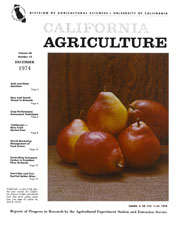


University of California
California Agriculture
|
|||
|
|||

Cover:
'California' - a new fresh market pear variety for California features bright red-colored fruit that turns yellow when ripe. - Photo by Jack K. Clark.
December 1974
Volume 28, Number 12 News and opinion |
|||
|
University of California, 1301 S. 46th St., Bldg. 478 Richmond, CA
|